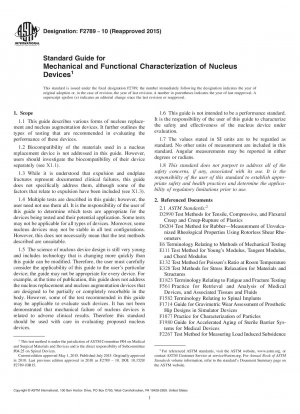ASTM F2789-10(2015)
Standard Guide for Mechanical and Functional Characterization of Nucleus Devices
- Standard No.
- ASTM F2789-10(2015)
- Release Date
- 2010
- Published By
- American Society for Testing and Materials (ASTM)
- Status
- Replace By
- ASTM F2789-10(2020)
- Latest
- ASTM F2789-10(2020)
- Scope
5.1 Nucleus devices are generally designed to augment the mechanical function of native degenerated nucleus material or to replace tissue that has been removed during a surgical procedure. This guide outlines methods for evaluating many different types of devices. Comparisons between devices must be made cautiously and with careful analysis, taking into account the effects that design and functional differences can have on the testing configurations and overall performance, and the possibility that mechanical failure may not be related to clinical failure and inversely, that mechanical success may not be related to clinical success.
5.2 These tests are conducted in vitro to allow for analysis of the mechanical performance of the nucleus device under specific testing modalities. The loads applied may differ from the complex loading seen in vivo, and therefore the results from these tests may not directly predict in vivo performance.
5.3 These tests are used to quantify the static and dynamic properties and performance of different implant designs. The mechanical tests are conducted in vitro using simplified loads and moments. Fatigue testing in a simulated body fluid or saline may have fretting, aging, corroding, or lubricating effects on the device and thereby affect the relative performance of tested devices. Hence, the test environment and the effect of that environment, whether a simulated body fluid, normal saline bath (9 g NaCl per 1000 mL H2O), or dry, is an important characteristic of the test and must be reported accurately.
5.4 Dynamic testing methods should be designed to answer the following questions, including but not limited to: Does the device still function as intended after cycling? Does it retain adequate performance characteristics (for example, mechanical and kinematic properties such as ROM)? Did the device wear or degrade? If there is evidence of wear or degradation of the device, it should be identified and quantified with reasonable methods generally available. The user shall distinguish between particulates generated by the device and particulates generated by the test model and fixtures if technically feasible.
1.1 This guide describes various forms of nucleus replacement and nucleus augmentation devices. It further outlines the types of testing that are recommended in evaluating the performance of these devices.
1.2 Biocompatibility of the materials used in a nucleus replacement device is not addressed in this guide. However, users should investigate the biocompatibility of their device separately (see X1.1).
1.3 While it is understood that expulsion and endplate fractures represent documented clinical failures, this guide does not specifically address them, although some of the factors that relate to expulsion have been included (see X1.3).
ASTM F2789-10(2015) Referenced Document
- ASTM D2990 Standard Test Methods for Tensile, Compressive, and Flexural Creep and Creep-Rupture of Plastics
- ASTM D6204 Standard Test Method for Rubber8212;Measurement of Unvulcanized Rheological Properties Using Rotorless Shear Rheometers
- ASTM E111 Standard Test Method for Young''s Modulus, Tangent Modulus, and Chord Modulus
- ASTM E132 Standard Test Method for Poisson''s Ratio at Room Temperature
- ASTM E1823 Standard Terminology Relating to Fatigue and Fracture Testing
- ASTM E328 Standard Test Methods for Stress Relaxation Tests for Materials and Structures
- ASTM E6 Standard Terminology Relating to Methods of Mechanical Testing
- ASTM F1582 Standard Terminology Relating to Spinal Implants
- ASTM F1714 Standard Guide for Gravimetric Wear Assessment of Prosthetic Hip Designs in Simulator Devices
- ASTM F1877 Standard Practice for Characterization of Particles
- ASTM F1980 Standard Guide for Accelerated Aging of Sterile Medical Device Packages
- ASTM F2267 Standard Test Method for Measuring Load-Induced Subsidence of Intervertebral Body Fusion Device Under Static Axial Compression
- ASTM F2346 Standard Test Methods for Static and Dynamic Characterization of Spinal Artificial Discs
- ASTM F2423 Standard Guide for Functional, Kinematic, and Wear Assessment of Total Disc Prostheses
- ASTM F561 Practice for Retrieval and Analysis of Implanted Medical Devices, and Associated Tissues
- ISO 10993 Biological evaluation of medical devices — Part 9: Framework for identification and quantification of potential degradation products
ASTM F2789-10(2015) history
- 2020 ASTM F2789-10(2020) Standard Guide for Mechanical and Functional Characterization of Nucleus Devices
- 2010 ASTM F2789-10(2015) Standard Guide for Mechanical and Functional Characterization of Nucleus Devices
- 2010 ASTM F2789-10 Standard Guide for Mechanical and Functional Characterization of Nucleus Devices

Copyright ©2024 All Rights Reserved